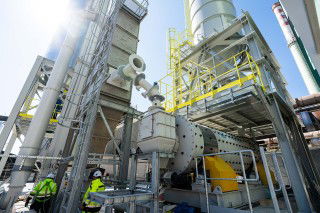This week, Brazil has been the country for a lot of developments in the cement industry. In particular, Votorantim announced it had completed its new production line in Pecem, Brazil, which also highlighted the cement sector's need to make its cement production more efficient and sustainable with lower emissions. The industry still has the larger topic of carbon pricing hanging over it and the introduction of new cement capacity will highlight the issue of some of the older plants that are not such low CO2 emitters.
The new production line is situated in the Pecém Industrial and Port Complex, Ceará, and has increased the cement capacity at the site from 0.2Mta to 1Mta. The BRL200m (US$38.26m) investment will increase cement sales to the Fortaleza region. Votorantim owns a railway line that transports raw materials and products between its plants at Sobral and Pecém, and the distribution centre in Mucuripe, Fortaleza. To enhance this distribution service, Votorantim has expanded its railway branch by 2.6km to shipped bagged products and stock its distribution centre.
"The completion of the Pecém plant also strengthens our competitiveness driver by focussing on operational excellence and offering to the market products that incorporate solutions that value quality and respect for the environment," said Edson Araújo, director of Brazil Operations at Votorantim Cimentos.
Lowering CO2 emissions
A significant part of Votorantim's announcement was that the new process at the Pecém facility emits 60 per cent less CO2 per tonne of cement produced than the previous manufacturing line at the plant. The company is aiming to reach net CO2 emissions of 520kg/t of cement produced by 2030, considerably lower than the world average of 637kg/t ,according to the GCCA international database. Between 1990-2020, Votorantim has reduced its CO2 emissions by 25 per cent from 763 to 576kg/t of cement.
Carbon pricing up for debate
While Votorantim has a clear sustainability strategy for reducing its CO2 emissions and Brazil is a signatory of the 2015 Paris Agreement to keep global temperatures rises below 2˚C, the dmestic cement sector is still debating how it will tackle carbon pricing. It was only in November 2020 that the Brazilian Association of Portland Cement (ABCP) and SNIC announced their official position on carbon pricing. They are largely in favour of a low-carbon economy, but proposed pricing should consider several factors, including the international context and historical efforts to reduce CO2 emissions. The associations also call for emission reduction efforts to take place across all economic sectors and it should be preceded by monitoring, reporting and verification. They also advocate that pricing systems via the market should be prioritised, rather than taxation and argued for a gradual implementation agenda to be discussed.
Brazil's 2050 cement technology roadmap
Brazil has a total of 92 cement plants controlled by 23 industrial groups and a cement capacity of 94Mta. With such capacity, Brazil can make a huge difference to the decarbonisation of the global cement sector. Therefore, the Brazilian 2050 Roadmap to a sustainable future was launched in 2019 in collaboration with the International Energy Agency (IEA), the International Finance Corp (IFC) of the World Bank, the World Business Council for Sustainable Development (WBCSD) and renowned Brazilian universities and technology centres.
To keep below the '2˚C Scenario' by 2030 the Brazilian cement sector must play its part by lowering CO2 emissions to 42Mta with an expected cement production of 87Mta in 2030. CO2 emissions will need to be kept at 44Mta in 2050 when Brazilian cement production is forecast to reach 117Mta.
According to the 2050 Roadmap, carbon capture in Brazil's cement sector is only expected to make a contribution in 2040 with 1.7Mt of CO2 captured and 3.3Mt of CO2 captured in 2050. However, most of the reductions of the sector's CO2 emissions will have to come from reducing the clinker factor of cement, alternative fuel usage and improved energy efficiency measures.
ICR’s August 2021 issue will include an exclusive article on Votorantim and its sustainability path, written by Marcelo Castelli, Global CEO of Votorantim Cimentos.
